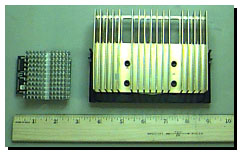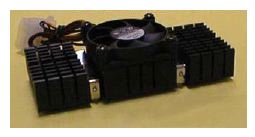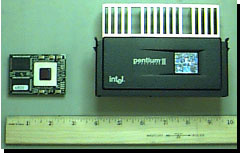Advocacy
Dojo (HowTo)
Reference
Markets
Museum
News
Other
![]()
Myths
Press
General
Hack
Hardware
Interface
Software
Standards
People
Forensics
Web
CodeNames
Easter Eggs
History
Innovation
Sightings
Opinion
Martial Arts
ITIL
Thought

![]()
|
Remember, in computers, smaller is better. Smaller means less power, less heat, lower cost, less physical size, and so on.
Since many people have never opened their machine (or the other platforms machine) -- I decided to take a couple of pictures.
The little silver hologram on the front of the Pentium Package is about the size of the PentiumII chip. The little Black square (surrounded by white) is the actual G3.
The two chips to the left of the G3 are the cache (this G3 has it's heat sink off, so it is naked). The PentiumII has a few chips inside the black plastic package.
If you notice that the PentiumII is black, forbidding and closed -- that is because it is. This is a proprietary package that Intel has not yet licensed to anyone else. If you buy a PentiumII you are buying a proprietary and closed solution. No one else can manufacture that carrier but Intel, no one else can make that processor, and you can't choose which cache you are using, and so on. Intel closed up their solution to make it more proprietary and try to starve out the chip competitors.
The PowerPC is in an industry standard socket (BGA), on a open little card (that you can get the design for), and uses standard SRAM (cache) that many others can manufacture. If you are a hardware designer or OEM, you can assemble these yourself. Of course you can buy the processors themselves from either IBM or Motorola (and there were a few other PowerPC licenses granted as well) -- and the whole PowerPC is an open design. (In serious contrast to Pentiums).
 The
picture to the right has the PowerPC G3 with its heat sink
on (and the Pentium II flipped over so you can see it's heat
sink). Doesn't the G3 package look tiny next to the massive
heat sink of the Pentium II?
The
picture to the right has the PowerPC G3 with its heat sink
on (and the Pentium II flipped over so you can see it's heat
sink). Doesn't the G3 package look tiny next to the massive
heat sink of the Pentium II?
I should have shot a picture from the end as well, so that you could see the Pentiums heat sink and package are about 3" deep (tall), while the G3 is less than half that.
In total volume, the G3 package is probably less than 1/8th the size of the PentiumII package.
Of course, it gets worse. The Xeon package is about twice the size of the PentiumII package (it is much taller). This is to house the bigger heat sink.
 The
other thing is that the Pentium II's often run so hot that
people put fans over the heat sink (just to be sure), and
there are stories of people burning themselves on the heat
sinks. While I've plucked the heat sink off a G3 (after
running for days) and it was pleasantly warm. I get the
feeling that the heat sink on the G3 is over engineered far
more than it needs to be, while the PentiumII is pushing it
right to the edge. Imagine your little special processor fan
breaking and your processor burning up -- it has been known
to happen in the Pentium camp.
The
other thing is that the Pentium II's often run so hot that
people put fans over the heat sink (just to be sure), and
there are stories of people burning themselves on the heat
sinks. While I've plucked the heat sink off a G3 (after
running for days) and it was pleasantly warm. I get the
feeling that the heat sink on the G3 is over engineered far
more than it needs to be, while the PentiumII is pushing it
right to the edge. Imagine your little special processor fan
breaking and your processor burning up -- it has been known
to happen in the Pentium camp.
The G4 uses about the same package as the G3. While Merced may come in a package that is even bigger than the Xeon (we have to wait to see).
If you wonder why the Pentiums in portables are like half as fast as the top end desktop machine -- these pictures should let you know why. Of course the same PowerPC that are used in desktops are also used in portables.
Every time someone tells me that CISC (Pentium) is as good as the RISC (PowerPC), I chuckle and think of this picture.
Intel had to pour 10 times as much money into design (as IBM and Motorola did) just to achieve almost the same performance (if you run it at far higher MHz) -- but they sure couldn't make it near the same size, power usage, cost, heat dissipation, and so on. I keep wondering if the next Pentiums are going to have to have liquid cooling (or powered cooling) just to keep them from burning up -- then I remember that active cooling is already options today (many Pentiums have required a fan or special coolers -- and if the fan breaks, your processor burns up).
Personally I like Pentiums they are so bulky and nostalgic, like those Intel guys in iridescent leisure suits dancing to 70's music -- they remind me of the refrigerator sized disk and tape drives, or big 8" floppy disks that I used in yesteryear. Yet somehow I doubt that is the image a high-tech company wants to cast.
|
